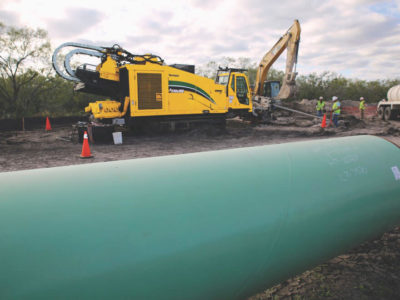Carbon capture is a process where carbon dioxide (CO2) is captured before it can enter the atmosphere, reducing greenhouse gas emission. This process is seen as a viable solution for energy companies striving to achieve carbon emissions goals.
Several companies in the biofuels industry are currently working on carbon capture, transportation and storage systems to reduce atmospheric emissions of human-made CO2. The process involves trapping the CO2 at its emissions source, transporting it via pipeline to a storage location — which is usually deep underground — and isolating it.
Once captured, CO2 can be transported via pipeline and permanently stored underground in geologic reservoirs. This model could be adopted by other industries that emit substantial quantities of CO2, such as fertilizer producers and power plants.
Building a carbon transport infrastructure
The United States currently has nearly 50 existing CO2 pipelines that span approximately 5,000 miles (8,046.7 km), with the CO2 mostly being used to squeeze more oil out of existing oil and gas wells. This is a process known as enhanced oil recovery (EOR). The CO2 is injected into the oil reservoir where it then expands and pushes additional oil to a wellbore.
According to the U.S. Office of Fossil Energy and Carbon Management, using CO2 injection for EOR was first tried in Scurry County, Texas, in 1972. It has now spread to western Texas, eastern New Mexico, Kansas, Mississippi, Wyoming, Oklahoma, Colorado, Utah, Montana, Alaska and Pennsylvania.
The recent emphasis on carbon capture has shifted the conversation away from EOR to a method of reducing CO2 emissions. The Midwest ethanol industry is an early proponent of the process as it strives to reduce carbon emissions and broaden its appeal as an environmentally responsible alternative to conventional petroleum-based fuels.
Three carbon capture pipelines are currently under consideration in the Midwest, including the $4.5 billion, 2,000-mile (3,218.7-km) Midwest Carbon Express proposed by Summit Carbon Solutions, which would carry CO2 across Iowa, Minnesota, North Dakota and Nebraska. The CO2 would be stored in the rock beneath North Dakota. A $3 billion, 1,300-mile (2,092.1-km) carbon capture pipeline planned by Navigator CO2 Ventures would transport CO2 from 18 ethanol plants in Iowa, Nebraska and South Dakota to an eventual destination in Illinois. Finally, Archer Daniel Midlands Co. (ADM), partnering with Wolf Carbon Solutions, wants to capture CO2 from ADM’s ethanol plants in Cedar Rapids and Clinton, Iowa, and move it through a 350-mile (563.3-km) pipeline to Illinois.
Before the pipelines can proceed, the companies need to secure right-of-way access.
In addition, other industries and regions are exploring carbon capture options. The Department of Energy recently announced plans to offer $2.54 billion to help finance six carbon capture and storage demonstration projects at coal- and gas-fired power plants as well as at industrial facilities.
“To meet President Biden’s climate goals, we have to rapidly decarbonize our power generation and heavy industries — such as steel production — that are essential to the clean energy transition,” said Jennifer Granholm, secretary of the Department of Energy.
Pipe considerations
Transporting CO2 does present challenges in terms of pipeline materials. Pure, dry CO2 is essentially non-corrosive to the carbon steel often used for constructing transportation pipelines. However, when CO2 dissolves in water, it forms carbonic acid, which is corrosive to carbon steel. This would require more expensive, corrosion-resistant alloys.
CO2 captured from power plants is likely to contain impurities such as NOx, SOx, etc. This has not been the case for existing pipeline used for EOR. More research will likely be needed to determine the best pipe for the application.
Horizontal directional drilling (HDD) can prove beneficial during the installation of these pipelines. Long runs of pipe can be put in place without disturbing the surface.
Contact your local Vermeer dealership for the tools and knowledge required to tackle construction of carbon pipeline infrastructure.
Vermeer Corporation reserves the right to make changes in product engineering, design and specifications; add improvements; or discontinue manufacturing or distribution at any time without notice or obligation. Equipment shown is for illustrative purposes only and may display optional accessories or components specific to their global region.
Please contact your local Vermeer dealer for more information on machine specifications. Vermeer and the Vermeer logo are trademarks of Vermeer Manufacturing Company in the U.S. and/or other countries. © 2022 Vermeer Corporation. All Rights Reserved.
